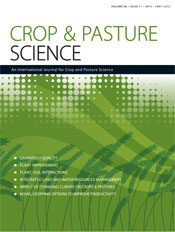Crop and Pasture Science
Volume 66
Number 11 2015
RESEARCH FRONT: Mineral Improved Crop Production
A 10- and 4-fold biofortification of bread wheat grains in Zn and Fe was carried out under controlled-environment conditions. Under field conditions without Zn and Fe, these grains kept enhanced levels without reaching the threshold of toxicity and with negligible modifications to grain texture and nutritional value.
Histidine enhanced, whereas glycine reduced, symplastic root Zn concentration in bread wheat. Both amino acids decreased symplastic root Zn concentration but had no effect on apoplastic Zn in triticale. Both amino acids decreased Zn concentrations in xylem sap of two plant species. Histidine, but not glycine, can enhance Zn uptake and translocation into the aboveground parts of triticale probably due to ability of histidine to form strong complexes with Zn.
An archival collection of Portuguese wheat varieties has been tested for selenium (Se) levels among its 48 cultivars of bread wheat (Triticum aestivum L.). Total Se in mature grains was determined by cyclic neutron activation analysis. Results show significant differences in Se accumulation between cultivars, not necessarily related only to soil features. Best candidates for an improvement of Se contents through breeding are cvv. Ideal, Ribeiro (b) and Ribeiro (a).
Different cropping practices affect absorption and accumulation of mineral elements in grain and consequently nutritional quality of the food produced. Intercropping of maize and soybean, in combination with microbiological and organic fertilisers, had positive impact on grain yield, as well as on Mg, Fe and Zn accumulation in grain. These cropping systems could serve as measure for increased yield and nutritional quality of maize and soybean grain.
Biofortification of leafy vegetables could be achieved by using hydroponic technology, like floating system. This study demonstrates that salad grown with a nutrient solution containing 10 µM selenate can accumulate Se in the leaves at levels compatible with the need in human diets and in available forms, i.e. Se-cysteine and Se-methionine. Se-treated plants showed benefits with respect to a decrease in nitrate content and increase in chlorophyll and carotenoid content.
Here we provide agronomic and physiological background for the quantitative assessment of spatial patterns of the thermal regimes for wheat, barley, canola, field pea and chickpea. By showing that Australian agriculture in the southern and western regions is Levantine rather than European, we advance a more accurate and relevant framework to the thermal regimes of winter crops. We outline the direct and indirect effects of temperature on crop traits and develop a conceptual framework to assess thermal effects on crop yield and adaptive practices.
A ‘root-mat’ approach was applied to investigate the P-dynamics in the rhizosphere of fababean (Vicia faba L.) and maize (Zea mays L.) grown in calcareous and acid soils. The effect of chemically-induced pH change from plant growth effects (such as mineralization and P uptake) on P dynamics has decoupled successfully in this study. The effect of soil pH on plant exudation response in P limited soils has also been demonstrated.
Uncertainty about the cause of photosensitisation in sheep grazing the annual forage legume biserrula is limiting adoption of this valuable pasture species. We examined the plant chemistry of biserrula to search for secondary plant compounds that might be responsible for causing photosensitisation. Although no known photosensitising compounds were found, the chemistry of biserrula is better understood with several flavone compounds identified.
This paper using a crop modelling approach assesses the agronomic potential of the maize and peanuts system under a changing climate in northern tropical Australia. Better yields and lower environmental risks will occur when maize with a greater sensitivity to higher temperature will be grown in cooler dry seasons and peanut in the wet seasons compared to their reverse sequence. Maize in the dry season and peanut in the wet season could, however, increase the demand of irrigation water if climate of the region were to become warm.
Lucerne (alfalfa) is the most nutritious and important forage crop worldwide. After breeding, it is difficult to know whether the genetic diversity present in the original population is maintained or decreased during the selection process. In this study, the genetic diversity detected in the fourth cycle was comparable to that of the original population, showing that the selection process was effective without reducing diversity.
Application of B fertiliser to B-deficient soil in eastern Victoria did not improve the effectiveness of R. leguminosarum bv. trifolii residing in those soils. However, there was some evidence that the N2-fixing ability of subterranean clover generated in B-deficient soils was enhanced by B fertilisation. There was also a suggestion that the symbiosis between plant and bacterium responded to B. The symbiotic mechanisms involved remain unknown.




